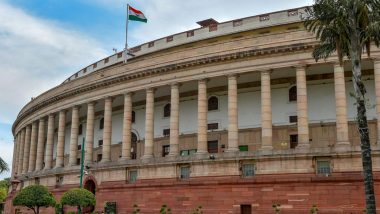New Delhi, January 31: Faced with all this uncertainty, the government of India opted for a "Barbell Strategy" that combined a bouquet of safety-nets to cushion the impact on vulnerable sections of society/business, with a flexible policy, said the Economic Survey 2021-22 which was presented in Parliament on Monday.
The last two years have been particularly challenging for policy-making around the world with repeated waves from a mutating virus, travel restrictions, supply-chain disruptions and more recently, global inflation.
This is a common strategy used in financial markets to deal with extreme uncertainty by combining two seemingly disparate legs. The iterative leg of this strategy is the same as the "Agile" approach that uses feedback-loops, and real-time adjustment. Economic Survey 2021-22: Govt Has Fiscal Capacity to Support Capital Expenditure.
The Agile approach is a well-established intellectual framework that is increasingly used in fields like project management and technology development. In an uncertain environment, the Agile framework responds by assessing outcomes in short iterations and constantly adjusting incrementally.
It is important here to distinguish Agile from the "Waterfall" framework which has been the conventional method for framing policy in India and most of the world. The Waterfall approach entails a detailed, initial assessment of the problem followed by a rigid up front plan for implementation.
This methodology works on the premise that all requirements can be understood at the beginning and therefore pre-commits to a certain path of action. This is the thinking reflected in five-year economic plans, and rigid urban master-plans.
The flexibility of Agile improves responsiveness and aids evolution, but it does not attempt to predict future outcomes. This is why the other leg of the Barbell strategy is also needed. It cushions for unpredictable negative outcomes by providing safety nets. This explains why the government's initial measures in 2020-21 were mostly about making food available to the poor, providing emergency liquidity support for MSMEs and holding the Insolvency and Bankruptcy Code in abeyance.
Once these were in place, the Government made its way forward by regularly announcing packages targeted at specific challenges. Contrast this with the approach adopted by many other countries pre-committing to a particular response path.
Sanjeev Sanyal, Principal Economic Adviser wrote in the introduction of the Economic Survey that the default mode of policy-making in India and most of the world has traditionally been to rely on a pre-determined "Waterfall" approach - an upfront analysis of the issue, detailed planning and finally meticulous implementation. This is the framework that underpins five-year plans and rigid urban master-plans.
"The problem is that the real world is a complex and unpredictable place buffeted by all kinds of random shocks and unintended consequences. The response of traditional economics was to create ever more detailed plans/regulations, and elaborate forecasting models despite more than adequate evidence that this did not improve outcomes. In his Nobel Prize acceptance speech, economist Friedrich Hayek dubbed this 'The Pretence of Knowledge," Sanyal said. Economic Survey 2021-22: India's GDP Projected to Grow at 9.2% in Current Financial Year.
This Economic Survey sets out to explain the alternative "Agile" approach that informed India's economic response to the Covid-19 shock. This framework is based on feed-back loops, real-time monitoring of actual outcomes, flexible responses, safety-net buffers and so on. Planning matters in this framework but mostly for scenario analysis, identifying vulnerable sections, and understanding policy options rather than as a deterministic prediction of the flow of events. The last Economic Survey did briefly discuss this approach, but this time it is a central theme, Sanyal said.
Some form of feedback loop based policy-making was arguably always possible, but the Agile framework is particularly relevant today because of the explosion of real-time data that allows for constant monitoring. Such information includes GST collections, digital payments, satellite photographs, electricity production, cargo movements, internal/external trade, infrastructure roll-out, delivery of various schemes, mobility indicators, to name just a few. Some of them are available from public platforms but many innovative forms of data are now being generated by the private sector. Short-term policy responses, therefore, can be tailored to an evolving situation rather than what a model may have predicted, Sanyal added.
(The above story first appeared on LatestLY on Jan 31, 2022 03:33 PM IST. For more news and updates on politics, world, sports, entertainment and lifestyle, log on to our website latestly.com).













 Quickly
Quickly












